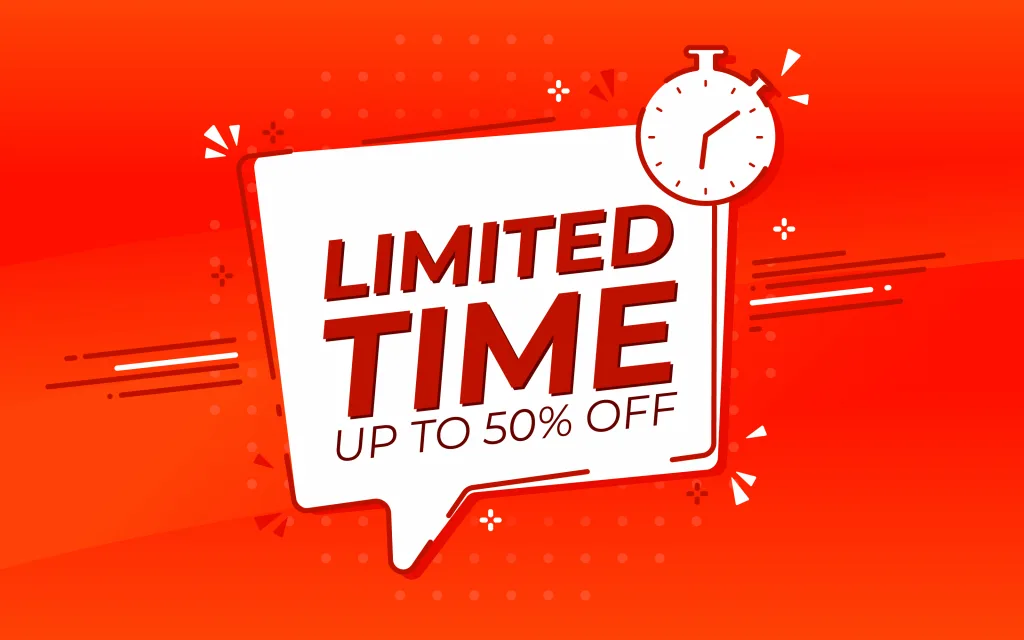In the fierce battle of customers, businesses are constantly seeking innovative strategies to capture the attention and interest of their consumers. One such technique that has proven to be highly effective is the scarcity selling technique. By creating a sense of urgency and of limited availability, this approach taps into the psychological principle known as scarcity.
Disclosure: If you click on my affiliate/advertiser’s links, I am going to receive a tiny commission. AND… Most of the time, you will receive an offer of some kind. It’ s a Win/Win!
Scarcity marketing revolves around presenting products or services as rare or in short supply, thereby triggering a fear of missing out (FOMO) among consumers. This technique plays on our innate desire for exclusivity and drives us to take immediate action.
The psychological impact of scarcity is profound. When faced with limited quantities or time-limited offers, individuals experience heightened motivation to acquire what is perceived as valuable and scarce. This can lead to increased sales, higher conversion rates, and a sense of urgency among consumers.
Throughout this post, I will have a deeper look into the scarcity selling technique and explore its various applications in marketing. I will also examine the psychological mechanisms behind its effectiveness and how businesses can leverage it ethically to drive customer engagement and boost sales. So, let’s go straight in and uncover the power of scarcity in influencing consumer behaviour.
The Different Types of Scarcity Tactics and How to Implement Them Effectively
Scarcity tactics are powerful tools that marketers use to create a sense of urgency and drive conversions. By leveraging the principles of limited availability, businesses can encourage customers to take immediate action. In this section, I will explore the different types of scarcity tactics and provide insights on how to implement them effectively.
One common scarcity tactic is the limited time offer. By setting a specific deadline for a promotion or discount, businesses can create a sense of urgency and motivate customers to make a purchase before time runs out. Countdown timers prominently displayed on websites or in marketing emails can further enhance this tactic by visually reminding customers of the impending deadline.
Another effective scarcity tactic is the limited quantity offer. By highlighting that there are only a certain number of products available, businesses can tap into customers’ fear of missing out (FOMO) and drive sales. This tactic works particularly well for high-demand items or exclusive releases.
Exclusive access offers are another form of scarcity tactic that can be highly effective. By offering early access or special privileges to a select group of customers, businesses can create an aura of exclusivity and entice others to join in order to gain access as well.
To implement these scarcity tactics effectively, it is important to strike a balance between creating genuine urgency and maintaining trust with your audience. It is important not to overuse these tactics or employ deceptive practices that may damage your brand’s reputation.
In addition, utilizing low stock notifications can be an effective way to leverage scarcity tactics without resorting to false claims. Notifying customers when stock levels are running low creates a sense of urgency while remaining transparent about product availability.
By understanding the different types of scarcity tactics and implementing them strategically, you can harness their power to increase conversions and drive customer engagement.
Let’s analyse these tactics in some more detail…
Creating a Sense of Urgency with Limited Time Offers
– Key points:
- The importance of setting a specific deadline for the offer
- Using countdown timers to visually represent the limited time remaining
- Showcasing the benefits and value customers will miss out on if they don’t act quickly
- Including clear call-to-action buttons to encourage immediate action
- Highlighting scarcity in promotional materials and messaging

Limited-time offers are a powerful marketing tool that can create a sense of urgency and drive immediate action from consumers. By setting a deadline for customers to take advantage of a special deal or discount, businesses can tap into the psychological principle of scarcity and motivate potential buyers to make a purchase.
One effective way to convey urgency is through time-limited deals, also known as flash sales. These promotions typically last for a short period, such as 24 hours or even just a few hours. By highlighting the limited availability of the offer, businesses can encourage customers to act quickly before they miss out on the opportunity.
Countdown timers are another effective strategy to create urgency in marketing. Placing countdown timers on websites or in promotional emails visually reinforces the limited time frame within which customers must act. Seeing the seconds ticking away can trigger a fear of missing out (FOMO) and prompt individuals to make an immediate decision.
When creating limited-time offers, it is important to clearly communicate the value and benefits that customers will receive if they take advantage of the deal. This helps potential buyers understand why they should act quickly and not delay their purchase.
Overall, incorporating limited-time offers into marketing campaigns can be an effective way to create a sense of urgency and drive conversions. By leveraging strategies such as time-limited deals, flash sales, countdown timers, and effectively communicating value propositions, you can motivate customers to take action before it’s too late.
Creating Demand with Limited Stock or Quantity-Based Offers
– Key points:
- Showcasing limited stock availability to create a sense of exclusivity and demand
- Mentioning how many items are left in stock or how many spots are available for a service or event
- Promoting limited edition products that won’t be restocked once sold out
- Offering special bonuses or incentives for early buyers
- Crafting compelling product descriptions that highlight scarcity and exclusivity
- Including social proof such as customer reviews or testimonials to increase credibility
Creating demand with limited stock or quantity-based offers can be a highly effective strategy for businesses looking to generate excitement and drive sales. Limited stock offers, also known as scarcity marketing, leverage the principle of scarcity to create a sense of urgency and exclusivity among consumers.
By offering a limited quantity of a product or service, businesses can tap into the innate fear of missing out (FOMO) that many individuals experience. This can lead to increased demand as customers rush to secure their purchase before the item runs out.
Quantity-based offers are another approach that can be used to create demand. By offering exclusive editions or versions of products, you can appeal to collectors and enthusiasts who are willing to pay a premium for something unique. Limited edition products often come with special features, designs, or packaging that differentiate them from regular offerings.
These strategies not only create excitement among consumers but also helps you manage inventory and control supply chains more effectively. By creating artificial scarcity, you can avoid overstocking and reduce the risk of excess inventory.
However, it is important to strike a balance when using limited stock or quantity-based offers. While these tactics can be highly effective in driving sales in the short term, they should be used strategically and ethically. Misleading customers with false scarcity claims can damage brand reputation and erode trust.
Leveraging limited stock offers and quantity-based offers is then an effective way for businesses to create demand and drive sales. By tapping into consumers’ desire for exclusivity and uniqueness, you can generate excitement around products while effectively managing inventory levels.
Start Your Business Today with Registered Agents Inc.Leverage the Feeling of Exclusivity with Special Offers
Exclusive access offers provide a range of benefits to VIP members, including early bird access promotions and invitation-only deals. These perks are designed to reward loyal customers and create a sense of exclusivity.
VIP membership benefits often include the opportunity to be the first to purchase new products or services before they are available to the general public. This early bird access promotion allows members to get their hands on highly sought-after items or limited-edition releases, giving them a sense of privilege and excitement.
In addition, invitation-only deals are another enticing feature of exclusive access offers. These deals are typically reserved for VIP members and provide them with special discounts, unique experiences, or exclusive products that are not available to non-members. By offering these invitation-only deals, businesses can foster a sense of exclusivity and make their VIP members feel valued and appreciated.
Overall, exclusive access offers provide VIP members with an enhanced shopping experience and additional perks that set them apart from regular customers. Whether it’s early bird access promotions or invitation-only deals, these benefits create a sense of exclusivity that can help businesses build customer loyalty and drive sales.

Using Scarcity in Pricing Strategies
– Key points:
- Offering limited-time discounts or promotional prices to create a sense of urgency
- Implementing price increases after a certain period or when stock is running low
- Using tiered pricing structures to offer different levels of access or benefits at varying price points
- Showcasing the value and benefits customers will gain by taking advantage of the limited-time pricing
- Communicating the reasons behind the limited availability or time-sensitive pricing strategy
Scarcity is a powerful psychological tool that can be effectively used in pricing strategies to drive consumer behaviour. By creating a sense of urgency and exclusivity, scarcity pricing techniques can encourage customers to make purchasing decisions more quickly and at higher price points.
One common approach is the use of limited-time discounts. By offering a time-limited promotion or discount, businesses create a sense of urgency for customers to take advantage of the deal before it expires. This can lead to increased sales as customers feel compelled to act quickly in order to secure the discounted price.
Another strategy is implementing price increases over time. By gradually increasing prices, businesses create a perception of scarcity and encourage customers to make purchases sooner rather than later. This can be particularly effective when combined with clear communication about future price increases, giving customers an incentive to buy now before the cost goes up.

Tiered pricing is another way to leverage scarcity in pricing strategies. By offering different levels or tiers of products or services at varying price points, businesses create a perception that certain options are limited or exclusive. This encourages customers to opt for higher-priced tiers, as they perceive them as more valuable and scarcer.
It’s important to carefully consider how to implement scarcity pricing techniques. While they can be highly effective in driving sales, it’s crucial not to deceive or mislead customers. Transparency and clear communication about the limited nature of discounts or availability are key factors in maintaining trust with consumers.
Using scarcity in pricing strategies really can be a powerful tool for businesses looking to drive consumer behaviour and increase sales. Limited-time discounts, gradual price increases, and tiered pricing are all effective approaches that leverage the psychology of scarcity. However, it’s important to use these techniques ethically and transparently in order to maintain customer trust and loyalty.

Creating a Persuasive Sales Copy that Capitalizes on Scarcity
– Key points:
- Create a sense of urgency through compelling language and phrases.
- Showcasing the benefits or advantages of acting quickly.
- Mentioning potential loss or regret if the opportunity is missed.
- Using scarcity-related keywords and phrases to reinforce the message.
Creating a persuasive sales copy that capitalizes on the scarcity selling technique can be a powerful strategy to drive customer action. Scarcity is a psychological principle that taps into people’s fear of missing out and creates a sense of urgency. By using persuasive copywriting techniques tailored to scarcity, you can effectively influence consumer behaviour and increase conversions.
One effective technique is to highlight limited availability or time-sensitive offers in your copy. By emphasizing that a product or service is in high demand or only available for a limited period, you create a sense of urgency that motivates customers to take immediate action.
Another approach is to use compelling language that conveys scarcity. Words and phrases such as “limited edition,” “exclusive offer,” “while supplies last,” or “only X left in stock” can evoke a sense of urgency and encourage customers to make a purchase before it’s too late.
Additionally, incorporating social proof into your copy can further enhance the persuasive impact of scarcity. Testimonials, reviews, or statistics that demonstrate high demand for your product or service can reinforce the idea that others are taking advantage of the scarce opportunity, prompting potential customers to do the same.
It’s important to strike a balance when using scarcity in your copywriting. While creating urgency is effective, it’s crucial to maintain authenticity and transparency with your audience. Avoid misleading claims or false scarcity tactics as they can damage trust and credibility.
By mastering persuasive copywriting techniques for scarcity selling, you can create compelling messages that tap into consumers’ fear of missing out and drive them towards taking action.
The Ethics of Scarcity Selling: Striking a Balance Between Persuasion and Honesty
– Key points:
- The importance of being transparent about scarcity claims and not misleading customers
- Avoiding false scarcity tactics that can damage brand reputation and customer trust
- Focusing on creating genuine value for customers through scarcity offers
- Balancing persuasion techniques with honesty and integrity in marketing communications
- Maintaining long-term customer relationships built on trust and satisfaction.
In marketing, scarcity selling has become a common tactic to create a sense of urgency and drive sales. However, there is an ongoing debate about the ethics of scarcity selling and whether it aligns with ethical marketing practices.
At its core, ethical marketing emphasizes transparency and honesty in communication with consumers. This means that marketers should provide clear and accurate information about their products or offers, including any scarcity tactics used. It is essential to strike a balance between persuasion and honesty when employing scarcity selling techniques.
One way to ensure ethical practices in scarcity selling is by being transparent about the limitations or restrictions associated with the offer. Marketers should clearly communicate any time-sensitive deals or limited availability of products, while also setting realistic limits that align with actual supply.
Moreover, providing genuine value alongside scarcity offers can help maintain ethical standards. Consumers are more likely to trust brands that consistently deliver high-quality products or services rather than relying solely on manipulative tactics.
Ultimately, the ethics of scarcity selling lie in finding a balance between creating urgency for sales purposes and maintaining transparency and honesty in marketing communications. By adhering to ethical principles and providing genuine value to consumers, marketers can build trust and long-term relationships with their audience.
Conclusion: Harnessing the Power of Scarcity to Drive Sales and Increase Conversions
In conclusion, harnessing the power of scarcity can be a highly effective strategy for driving sales and increasing conversions. The scarcity selling technique has been proven to create a sense of urgency and exclusivity among consumers, motivating them to take action and make a purchase.
Scarcity marketing involves creating a perception of limited availability or time-sensitive offers, which taps into the fear of missing out (FOMO) that many individuals experience. By highlighting limited stock, limited-time promotions, or exclusive deals, businesses can create a sense of urgency that compels customers to act quickly.
This approach can be particularly effective in e-commerce settings where customers have numerous options and distractions. By leveraging scarcity tactics such as countdown timers, limited edition products, or flash sales, businesses can capture attention and drive immediate action from potential buyers.
The use of scarcity in marketing not only increases the likelihood of making a sale but also helps to boost conversions. When customers perceive an item as scarce or in high demand, they are more likely to view it as valuable and desirable. This perception can lead to increased conversion rates as customers are motivated to secure the product before it runs out.
However, you need to strike a balance when using scarcity tactics. Overusing this technique may lead to customer scepticism or even alienation if they feel manipulated or misled. You must maintain transparency and integrity in your marketing efforts while effectively utilizing scarcity techniques.
The bottom line therefore is: incorporating scarcity into your marketing strategy can be an effective way to drive sales and increase conversions. By creating a sense of urgency and exclusivity around your products or services through limited availability or time-sensitive offers, you can tap into consumer psychology and motivate them to take action. Remember to use this technique responsibly while maintaining transparency with your customers for long-term success.
- How Live Shopping Can Skyrocket Your Small Business Sales: The Ultimate Guide to Getting Started
- Turn AI Anxiety into Competitive Advantage: How to Future-Proof Your Workforce for the AI Revolution
- Unlock Profit: Calculate Customer Lifetime Value & Maximize Growth
- Creating a Customer Persona: A Step-by-Step Guide On How To Do It
- Unleashing the Power of Digital Signage: The Best Software to Transform Your Business








